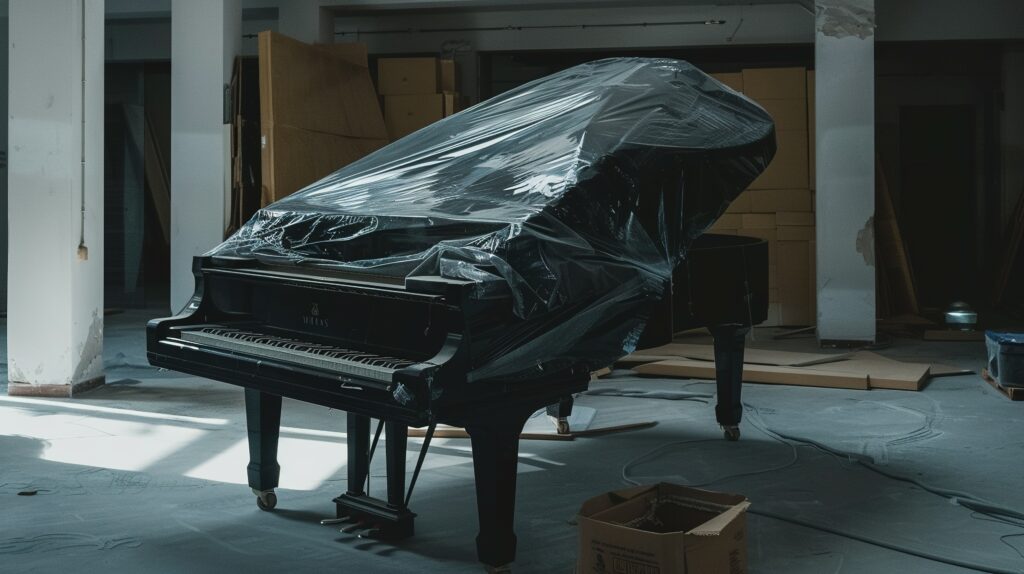
A piano is a delicate instrument that requires careful handling, especially when it comes to storage. Whether it’s being stored for a few weeks or several years, proper precautions must be taken to protect its structure and sound quality. Factors like temperature, humidity, positioning, and covering all play a role in keeping the instrument in top condition. Without the right storage methods, a piano can suffer from warped wood, rusted strings, or detuned keys. For those looking for professional assistance, piano movers Denver like Mountain Piano Moving Company can ensure safe transportation and placement. This guide explores the best short-term and long-term storage solutions for your piano.
Climate-Controlled Storage – Preventing Wood Warping and Tuning Issues
1. Why Temperature and Humidity Matter
Pianos are highly sensitive to fluctuations in temperature and humidity, as they are made of wood, felt, and metal components. Extreme heat or dryness can cause the wood to shrink and crack, while excessive humidity may lead to swelling, sticking keys, or mold growth. These changes affect not only the piano’s physical condition but also its ability to stay in tune.
2. Benefits of Climate-Controlled Storage Units
Investing in a climate-controlled storage unit ensures the piano remains in an environment with stable temperature and humidity levels. Ideally, the humidity should be kept between 40% and 50%, and the temperature should be between 65°F and 75°F. While climate-controlled storage may cost more than standard storage, it significantly reduces the risk of damage and costly repairs.
3. Alternatives for Home Storage
If a storage facility isn’t an option, homeowners should place the piano in a room with a consistent climate. Avoid basements, garages, and attics, as these areas experience extreme temperature shifts. A centrally located room, away from windows and vents, is ideal for keeping the piano in good condition.
Proper Covering and Protection – Using Breathable Fabric Instead of Plastic
1. Avoiding Moisture Traps
One of the biggest mistakes people make when storing a piano is covering it with plastic. While it may seem like a good way to protect against dust, plastic traps moisture, which can lead to mold growth and warping. Instead, a breathable fabric cover allows for air circulation while still offering protection.
2. Choosing the Right Material
A high-quality quilted piano cover or a thick cotton sheet is ideal for preventing dust accumulation and minor scratches. Commercially available piano covers provide added protection against accidental bumps or exposure to sunlight, which can fade the piano’s finish over time.
3. Securing the Cover for Maximum Protection
It’s important to ensure the cover is properly secured but not wrapped too tightly around the piano. Tight coverings can create unnecessary pressure on the instrument, leading to stress on the frame or keys. If the piano is stored in a high-traffic area, consider additional padding around the edges to prevent accidental impact damage. Learn the importance of professional services for your piano moving service, read “Why You Should Always Hire Professional Piano Movers.”
Positioning the Piano Correctly – Keeping It Stable and Away from Moisture
1. Keeping It Off the Ground
Never store a piano directly on a concrete or tile floor, as these surfaces tend to retain moisture, which can seep into the wooden components. Instead, elevate the piano slightly using a furniture dolly, wooden pallets, or rubber pads. This not only prevents water damage but also allows for better air circulation around the instrument.
2. Avoiding Windows and Air Vents
Exposure to direct sunlight from windows can cause the piano’s finish to fade and its wood to dry out. Similarly, placing the piano near an air vent or radiator can lead to uneven temperature fluctuations, making it harder to maintain its tune. A stable, interior room with controlled airflow is the best placement for a stored piano.
3. Stabilizing the Legs and Frame
If the piano is stored on an uneven floor, its weight may put stress on the legs and frame, leading to warping over time. Using leveling pads or rubber stabilizers can help distribute weight more evenly and keep the instrument stable. A wobbly or improperly balanced piano is more susceptible to long-term damage.
Regular Maintenance in Storage – Checking for Damage or Temperature Changes
1. Inspecting for Cracks or Warping
Even when a piano is in storage, regular inspections are necessary to ensure it remains in good condition. Every few months, check for cracks in the wood, separation in the soundboard, or signs of warping. Early detection of these issues can prevent more extensive damage later.
2. Monitoring Humidity Levels
Using a hygrometer in the storage area allows owners to track humidity levels and make necessary adjustments. If the humidity is too low, a small humidifier can be used to add moisture to the air. Conversely, a dehumidifier or moisture-absorbing packets can help in overly humid conditions.
3. Cleaning and Dust Removal
Dust buildup can affect the keys and internal components of the piano over time. Light dusting with a microfiber cloth every few months helps keep the instrument clean. Avoid using liquid cleaners, as excess moisture can seep into the wood and damage the finish.
When to Move a Stored Piano – Knowing the Right Time to Relocate It
1. Signs of Environmental Damage
If the piano starts showing signs of cracking, key misalignment, or excessive tuning instability, it may be in an unsuitable storage environment. Relocating it to a climate-controlled space can prevent further damage. Pay attention to any warping in the frame or rusting of the metal components, as these indicate poor storage conditions.
2. Preparing for a Move
Moving a stored piano should be done carefully to avoid unnecessary strain on its internal components. Before transport, secure all removable parts, such as the keyboard cover and pedals, and use professional-grade moving blankets. Professional piano movers can ensure the instrument is safely relocated without damage.
3. Re-Tuning After Storage
Once the piano is placed in a new location, it needs time to acclimate to its new environment before tuning. Pianos often shift slightly due to temperature and humidity changes, so it’s best to wait two to three weeks before scheduling a professional tuning session.
Conclusion
Proper storage is essential for keeping a piano in optimal condition, whether it’s for a few months or several years. Using climate-controlled storage, breathable coverings, stable positioning, and routine maintenance ensures the instrument remains structurally sound and playable. If storage conditions become unfavorable, relocating the piano with the help of piano movers is a smart decision. By taking the right precautions, owners can extend the lifespan of their instrument and maintain its quality.
Your piano is more than just an instrument—it’s a valuable investment that deserves expert care. When it comes to moving and storing your piano safely, Mountain Piano Moving Company is here to help. Our professionals specialize in careful handling, secure transportation, and climate-friendly storage solutions. Don’t risk damage by storing or moving your piano improperly. Contact us today for expert assistance and keep your piano in pristine condition.

